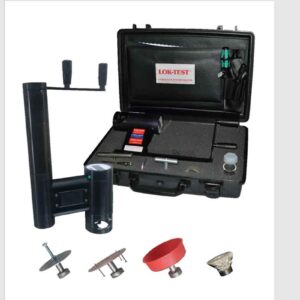Description
Principle
A disc with an integral ring, 55-mm inner diameter and 75-mm outer diameter, is bonded to the surface using a rapid curing adhesive (GRA) and is used to impart shearing stress to the test surface.
For tests of bare concrete, the surface should be prepared first with a diamond planing tool to produce a flat surface and to expose the coarse aggregate. Before bonding the ring, a special double -barrel coring bit is used to produce partial cores as illustrated below. The coring bit diameters match the inner and outer diameters of the ring.
 After the adhesive has cured, a torque is applied to the ring until rupture occurs due to shearing stress. The torque is applied with a special torque housing that is anchored to the surface. The loading is accomplished with the pull machine used for the CAPO-TEST. The load from the pull machine is applied eccentrically to the torque housing, thus producing a torsional moment.
After the adhesive has cured, a torque is applied to the ring until rupture occurs due to shearing stress. The torque is applied with a special torque housing that is anchored to the surface. The loading is accomplished with the pull machine used for the CAPO-TEST. The load from the pull machine is applied eccentrically to the torque housing, thus producing a torsional moment.
The peak force is recorded and is converted to a shear strength using the provided conversion relationship, as shown above (right).
Additional information can be found in the following reference:
Petersen, C.G. and Poulsen, E., “In-Situ Testing of Near-to-Surface Layer of Concrete and Epoxy-Bonded CFRP Strips,” US-Canada-Europe Workshop on Bridge Engineering, Zürich, Switzerland, 1997.
Variation
The coefficient of variation of replicate test results is about 10 % on concrete with a maximum aggregate size of 38 mm.







Reviews
There are no reviews yet.